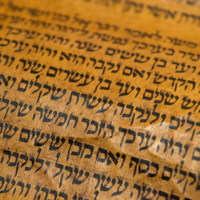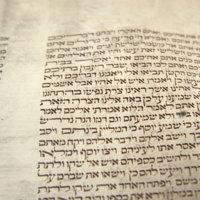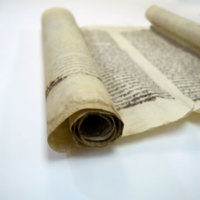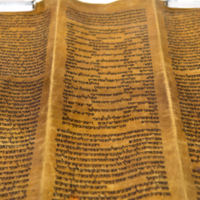Scrolls by Country
(click images below for more photographs and detailed information)
Algeria
The two scrolls from Algeria are estimated to be 220 and 300 years old, respectively. Written on gevil parchment, both scroll fragments deal with laws and societal norms.
Egypt
Both Egyptian scroll fragments are from the same, larger scroll. They are estimated to be around 300 years old and are well-preserved. Of particular stylistic note on these fragments is the use of "Peh Lefufah" at certain points in the text, as well as a lack of "Tagin" (Crownlets).
Germany
Although being identified as from Germany by the original seller, it is possible that MS 1027 was actually produced in one of the Baltic States bordering Russia. Nonetheless, the fragments below were all written on Klaf parchment and range in age from 90 to 160 years. Each fragment has a distinct writ, which is discussed at greater length on the manuscripts' individual pages. Also of note is the extraneous decoration of MS 1039, which is forbidden in Torah law (except when applied to the Scroll of Esther).
Holland
All of the Torah fragments from Holland are excerpts from Genesis. MS 1033 and 1034 are fragments from the same scroll, are written on Klaf Mashuach parchment, and are estimated to be 200 years old. MS 1035 is slightly newer, being only 170 years old. All three fragments are written in a Western Sephardic hand typical of the Spanish exiles who immigrated to Holland.
Hungary
The Hungarian fragment below details the birth of Isaac. It is estimated to be 180 years old and is written on Klaf Mashuach parchment.
Iraq
The fragments from Iraq are estimated to be 150, 85 to 200, and 300 years old, respectively. All are written on gevil. MS 1011 was likely written by three different scribes, as evidenced by penmanship and described in greater detail on its individual webpage.
Israel
MS 1059 is one of two complete scrolls in the Singer collection. Originating in Israel, it contains the complete book of Genesis and the first eight chapters of Exodus. It is by far the largest fragment in the collection, being over 41 feet long. It is estimated to be 90 years old and is written on Klaf Mashuach parchment. The roller and calligraphy are also of particular note and are described in greater detail on the manuscript's page.
Italy
The fragments from Italy are all written on klaf parchment. MS 1036 and 1037 are fragments from the same scroll and are 180 years old. MS 1044 and 1051 are likewise estimated to be 180 and 150 to 200 years old, respectively. The latter two fragments are written in a hand borrowed heavily from the Spanish school, as evidenced by the style of writing, which is described more thoroughly in individual pages.
Latvia
Both fragments from Latvia are from the same scroll. About 110 years old and written on klaf parchment in Ashkenazi hand, these fragments likely came to Israel 50 years ago from Riga, Latvia. Of particular note is a portion of MS 1046 containing a fragment of the Ten Commandments.
Morocco
The scrolls from Morocco range greatly in age, topic, and material. MS 1003 is one of two complete scrolls in the Singer collection. Written on klaf parchment and around 240 years old, it is a complete scroll of Esther with the original roller. MS 1020, 1025, 1054, and 1055 are all written in the same Spanish / Moroccan hand on deep warm gevil, which remains well-preserved despite the fragments' estimated age of 400 to 450+ years (making them among the oldest in the collection). MS 1042 is placed at a younger 230 and written in a North African calligraphy pattern on gevil. Lastly, MS 1058 has a number of distinguishing written features detailed more in the fragment's individual page and is estimated to be around 190 years old.
North Africa
The North African fragment documents the initial revelation of God to Moses at the burning bush and His charge to liberate the Children of Israel from Egypt. Estimated to be 200 years old and written on gevil, this fragment is also notable for the inserting of the words "Ani Ado-nay" (I am the Lord) in very fine calligraphy in between the lines, which can be seen clearly in photographs on the manuscript's individual page.
Persia
All four scroll fragments from Persia are written on gevil. Each manuscript is of particular narrative note: MS 1015 has a correction to repair the Sacred name of God, MS 1016 has the Song of the Crossing of the Sea of Reeds, MS 1053 details the Menorah-lighting process and the first Passover, and MS 1057 covers Joseph's temptation with the wife of Pontiferah.
Poland
The fragments from Poland are 200 and 150 years old, respectively. MS 1028 discusses -- among other things -- what one is to do when encountering a bird's nest. MS 1029 contains the story of Jacob and Laban in Genesis. Both fragments are written on klaf parchment.
Tunisia
All seven fragments from Tunisia are written on gevil. They range in age from 130 to 200 years old. MS 1005, 1012, and 1024 are from the same, larger scroll.
Yemen
The single scroll fragment from Yemen is estimated to be 115 years old. Written on gevil, the scribe used a Hebrew calligraphy style.









































